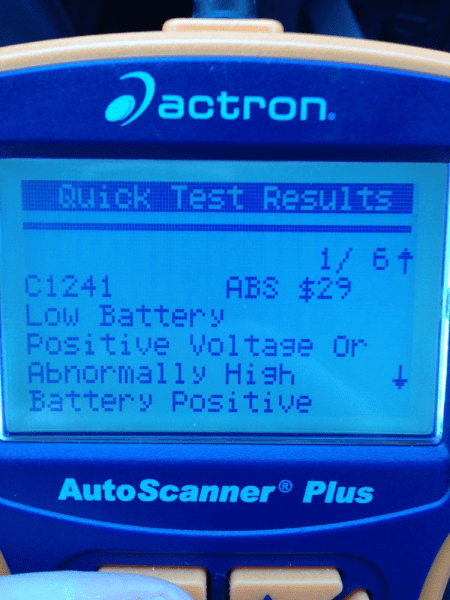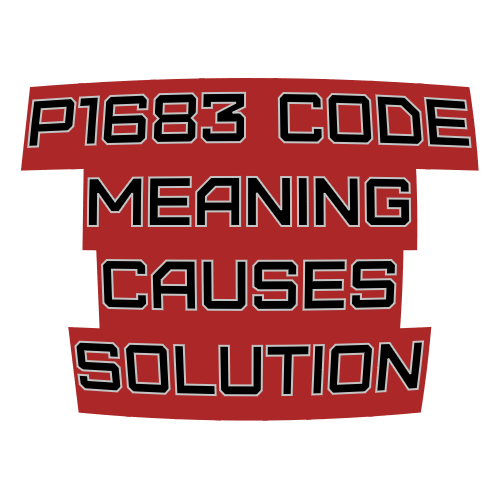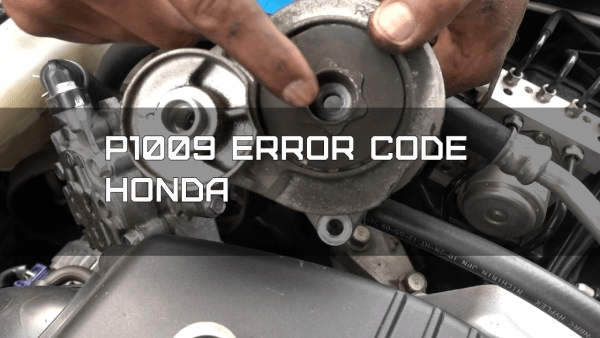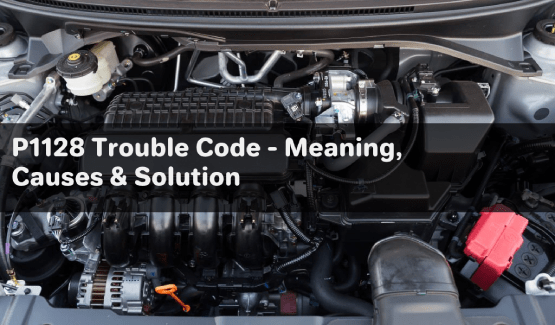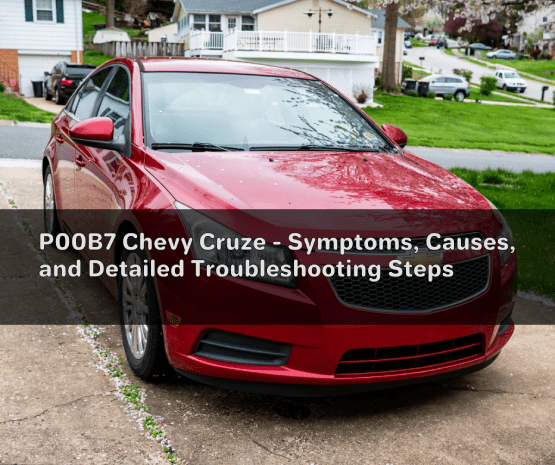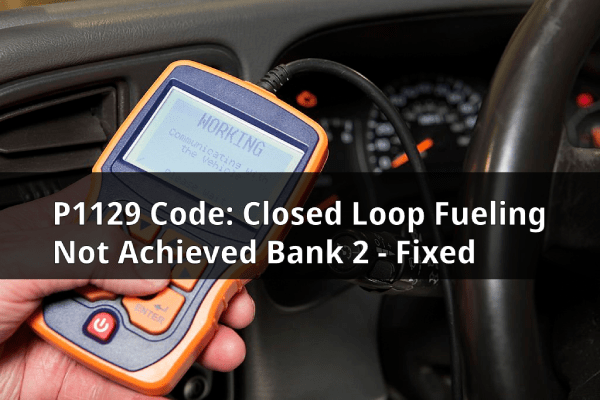For many years, the internal combustion engine has served us faithfully. And while we enjoyed the ease it brought to our lives, it did not take too long to notice that the price for that comfort was steep. You see, the ICE is notorious for its emissions. Carbon dioxide, Carbon monoxide, Nitrogen, particulate matter, you name it. The story is the same whether you are driving a gasoline or a diesel engine. You are releasing tons of greenhouse gases into the environment, precisely about 4.6 metric tons per year if you own a passenger car. Believe me, a lot is being done to reduce emissions from the ICE.
Most modern cars come equipped with components to help reduce emissions released into the environment. These components (e.g. the catalytic converter) do a good job of making our environment safer. This is why our vehicles warn us when these components fail to work as they should. The warning comes in the form of error codes. I will discuss one such error code in this article – Code P20EE.
What Does the Code P20EE mean?
Most error codes signal an issue with a specific component of the vehicle. In the case of Code P20ee, it is the selective catalytic reduction catalyst (SCR). The SCR catalyst system was introduced to all diesel engines manufactured after 2010. The system helps reduce pollutants, especially Nitrogen Oxide (NOx) produced by the engine through a catalytic reaction.
If the SCR has failed or is not performing at maximum efficiency, then more Nitrogen Oxide will escape into the environment through the exhaust fumes. The vehicle’s system will detect the presence of a higher-than-normal NOx. When this happens, the check engine light will come on alongside the error Code P20ee meaning “SCR NOx Catalyst Efficiency Below Threshold.” Brace up, things are about to become more technical as I explain all this.
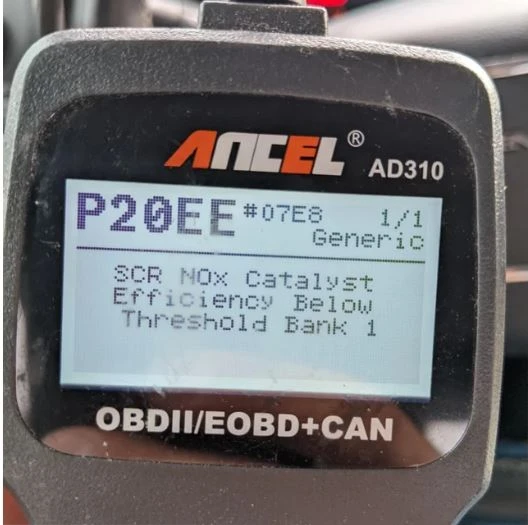
What is SCR NOX Catalyst?
Catalytic converters are of two types; two-way converters and three-way converters. The two-way catalytic converters can only convert harmful carbon monoxide gas and other hydrocarbons into carbon dioxide and water through an oxidation reaction. The disadvantage of the two-way cat converter is that it cannot break down oxides of Nitrogen (abbreviated NOX), which are also by-products of the ICE. This is where the three-way cat converters come in. Introduced in 1981, the three-way cat converters can break down NOX into less harmful forms (Nitrogen and water) in a reduction reaction.
In a diesel engine, emissions go through four stages; recirculation of the exhaust gas, diesel particulate filtration (DPF), diesel oxidation catalyst (DOC), and selective catalytic reduction (SCR). In the SCR stage, the oxides of Nitrogen present in the exhaust fume are reduced to Nitrogen and Oxygen. The component responsible for carrying out the reduction reaction is the SCR NOX Catalyst. To do this. The SCR catalyst injects a regulated amount of Diesel Exhaust Fluid (DEF) into the exhaust stream. In this case, the DEF acts as a catalyst setting off a reduction chemical reaction that converts NOX into elemental Nitrogen gas, which is harmless to the environment. Note that some SCR catalysts may use ammonia or urea as a catalyst.
The SCR’s efficiency is between 75 to 90%, meaning that trace amounts of NOX still escape into the atmosphere. However, there is an acceptable threshold, and the powertrain control module (PCM) monitors the entire process using NOX sensors. If the NOX sensors pick up a higher-than-normal quantity of NOX in the exhaust fumes, it means there is a problem with the SCR catalyst. In response to this, the system displays the error Code P20EE.
Symptoms of P20EE Code
Common symptoms of the P20EE error code are;
- Check engine light will come on – the first sign of a malfunction in the engine is the check engine light. This could indicate any number of issues with the engine, including high NOX emission.
- The exhaust light or emission light will come on – this warning light is an indication that there is a problem with the exhaust system of your vehicle. Although this is more specific than a check engine light, you will still need an OBD scanner to know the exact cause of the problem.
- Engine derating – a self-preserving mechanism where the engine’s output (power) is automatically reduced because the operating condition is not ideal.
- Poor fuel efficiency
What causes the P20EE error code?
There are several reasons why you may see this code. However, the most common one (as I have discussed so far) is a faulty SCR NOX catalyst. Even so, your SCR may be just fine, yet you see the Code P20EE on your dashboard. In that case, it could be due to a;
Defective O2, NOx, or temperature sensor
There are three important sensors in the exhaust system. These are the O2 sensors, the NOx sensor, and the temperature sensor. Each of these sensors has a unique role to play in ensuring that the exhaust system is functioning. The O2 sensors measure the amount of oxygen in the exhaust fumes. There are often placed before and after the catalytic converter to measure the amount of oxygen in the exhaust fumes entering and leaving the system. The NOx sensor operates similarly to the O2 sensor, measuring the volume of Nitrogen oxides in the exhaust fumes.
The exhaust temperature sensor measures the temperature of the exhaust gases in a diesel engine to optimize the regeneration of the diesel particulate filter (DPF). Unlike the other two sensors, there can be up to 4 temperature sensors in an engine. All three sensors are critical to the treatment of the exhaust fumes leaving the vehicle. If either one of these sensors becomes defective, the system detects this and relays the information back to the driver in the form of an error code, and course a check engine light.
Inoperative SCR system
The SCR system handles the reduction of NOx present in the exhaust gas. If the system fails to operate as it should, then there will be a higher concentration of NOx in the exhaust fumes. The NOx sensor will detect this and relay it back to the system with a P20EE error code. Because the NOx sensor indirectly measures the SCR catalyst system’s efficiency, the P20EE error code stands for “SCR NOx Catalyst Efficiency Below Threshold”.
Faulty SCR injector
The selective catalytic reduction system works by injecting a reducing agent (in this case, the Diesel Exhaust Fluid – DEF) into the exhaust gas stream. The DEF acts as a catalyst initiating the reduction reaction that turns NOx into Nitrogen and water. If the SCR injector is faulty, the DEF will not be injected in the right amount, and sometimes it may not be injected at all. The implication is that most (or all) of the NOx gas will not be reduced. Again, the NOx sensors will pick up the high volume of Nox in the exhaust fume and send out a warning alert in the form of Code P20EE.
Incorrect or Insufficient DEF fluid
The DEF fluid must be replenished from time to time. Low DEF will set off several alerts like engine derating and limited engine speed. If the DEF is still not replenished on time and eventually runs out, the vehicle might become completely immobilized until the fluid is refilled. The same thing happens when an incorrect amount of DEF is injected into the system. Not only does this affect the vehicle’s performance, but it also releases toxic gases into the environment. Thus the aim of having the SCR system is defeated. To prevent all these, the vehicle’s electronic control unit will alert the driver once there is any abnormality in the quantity or volume of DEF injected into the system.
Additionally, the P20EE error code could be a result of a faulty SCR controller, a programming error, leaking exhaust gas, or installation of aftermarket exhaust components, all of which could hurt the operation of the SCR system.
Is it safe to drive the vehicle with a P20EE error code?
No, if you see the P20EE error code, don’t look the other way. Doing so will likely cost you more in the long run. Because there are many possible causes of this code (which is why it is referred to as a generic code), it is difficult to know precisely what is causing it unless you have it checked out. So ignoring the code could have a detrimental effect on your vehicle. This could be a mild outcome like derating the engine and limiting driving speed to more severe outcomes like rendering the car immobile and even damaging certain engine components. Overall, you are better off not driving the vehicle things get sorted out.
How to fix the P20EE error code
Unfortunately, there is no quick fix for this error code. You would have to visit an experienced mechanic who would identify and fix the problem. Any attempt to do so on your own without adequate knowledge and experience will not only be time-consuming but could also lead to a much bigger problem.
Conclusion
Error codes, by their nature, imply problems which is why no one likes to see them. But it is also true that not all error codes are problematic. Some are simply warning bells meant to help us evade a possible disaster. Code P20EE being a generic code, can be a warning of an impending problem or a notification of a much-dreaded disaster. Whatever the case, this article will help you understand what is going on in your vehicle.
Iliah is the co-founder of Mechanic Ask, where he writes detailed step-by-step tutorials for repairs and mods. He also posts videos walking through things like engine swaps, suspension lifts, and tuning chips. Iliah uses his blog as an educational resource for car enthusiasts based on the knowledge he’s gained from 15 years as an ASE-certified master technician. His repair manuals provide even novice readers the confidence to take on big projects.

